Imagine if you could improve retention in your hospital by making your team feel safer at work. Now imagine if the same solutions for protecting your staff also helped reduce hospital costs and allowed clinicians to focus on what they do best – care for patients!
Innovative security solutions for hospitals can prevent attacks, streamline check-ins, reduce workplace injuries, and improve patient experience. To illustrate how these solutions work, we’ll examine the emergency department where 50% of clinicians report being assaulted on the job. You won’t find any ads or product spam, just an unbiased introduction to the systems you should be considering for your hospital.
We’ll breakdown the E.D. in these three areas as we provide details on how each solution better protects your team and improves operations.
1. Entry and Waiting Room
2. Emergency Department & Patient Rooms
3. Perimeter
1.) Emergency Department Entry & Waiting Room
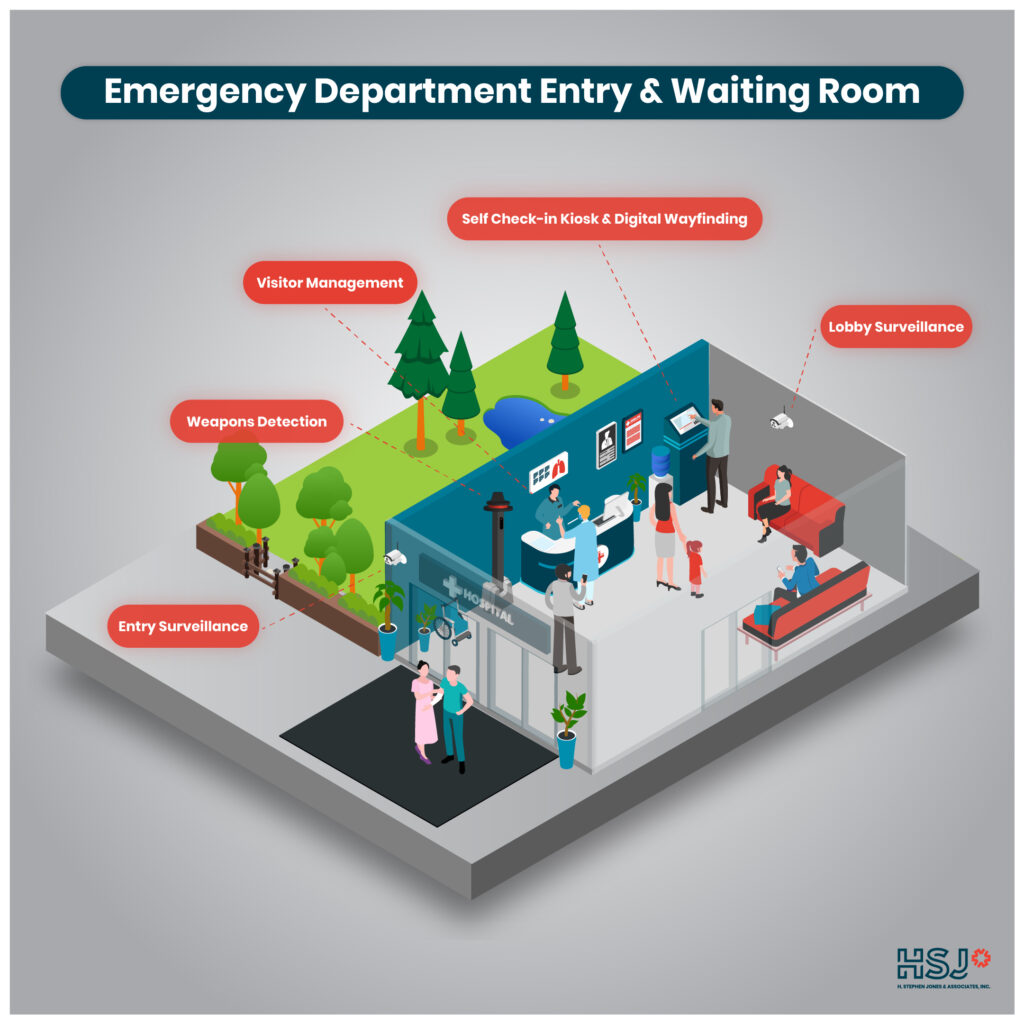
Entry Surveillance with Advanced Analytics
Violent attacks in hospitals are happening at an alarming rate with multiple shootings throughout the country in just the last few months. New surveillance systems with advanced analytics can better protect your staff by identifying anyone carrying a weapon near your hospital and immediately alerting staff to the threat. These smart cameras will also send automatic alerts if a patient that has caused problems in the past comes back to the hospital. Early warnings for potential threats help staff be proactive in protecting themselves and others from attacks.
Weapons Detection
Weapons screening systems are essential for preventing any guns, knives, razor blades, and other high-risk items from getting into the hospital. Screening systems can be boldly displayed to deter potential attackers or be more covert so they do not negatively impact the patient experience. Either approach will still provide a much needed layer of protection for clinicians, patients and guests.
Visitor Management
You can’t protect your staff and patients if you do not know who is inside your hospital. Enacting visitor management policies, procedures, and systems will give you visibility into who is coming into your building and what their purpose is for being there. These systems can also help identify people with warrants and known sex offenders that may pose a greater risk to staff.
Lobby Surveillance
Patients and visitors can become agitated quickly during their wait. To effectively monitor for potential violent outbreaks, you need surveillance coverage that gives you visibility to the entire waiting room/lobby. Smart analytics on these cameras can also detect if someone is making aggressive movements or using threatening language. In healthcare environments where attacks happen more frequently, smart analytics are highly recommended to instantly alert staff of potentially violent events so they can deescalate situations or get to a safe place quickly.
Self-Service Check-in Kiosk & Digital Wayfinding
Self-service check-in kiosks help you deliver a streamlined experience for patient registration and can be combined with Visitor Management Systems. When executed well, these systems can also reduce wait times by integrating with your hospital’s check-in systems. Patients are able to register for treatment online and then they are alerted on their mobile device when they are ready to be seen. These kiosks and mobile check-in experiences can also provide guidance on where the patient should go within the facility to be treated.
2.) Emergency Department & Patient Rooms
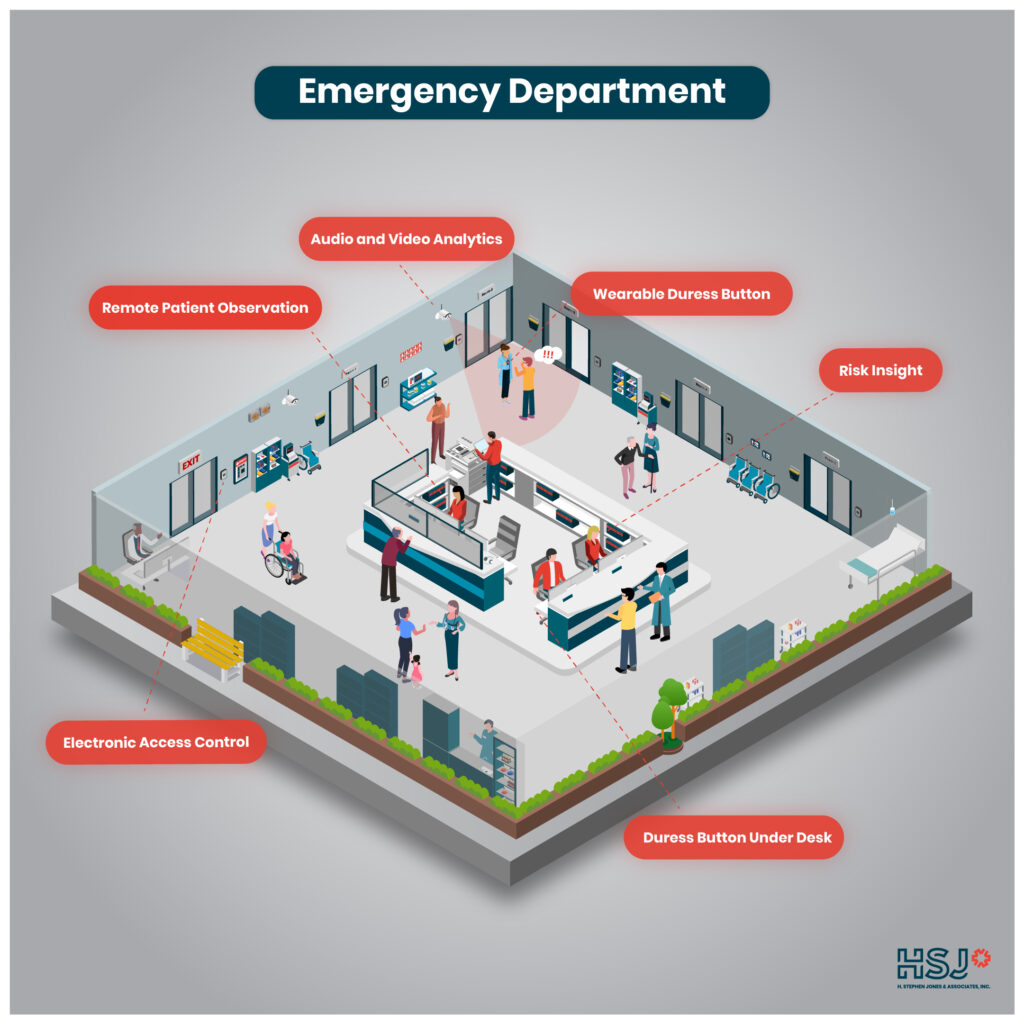
Wearable Duress Buttons
Instant access to discrete duress alarms is invaluable in hospitals where violence can erupt without warning. Wearable duress buttons can be embedded in ID badges or added to lanyards that provide staff with the ability to easily (and discretely) call for help when they feel threatened. The wearable duress device will also give security the exact location of the person requesting assistance. Enabling clinicians to request immediate assistance with a wearable duress button will better protect them and show them that leadership is prioritizing their wellbeing.
Electronic Access Control
New advancements in access control systems allow for contactless and biometric based access to secure areas in the emergency department. With situations in the ED changing rapidly, these access control system features can improve clinical workflows and reduce burnout.
Audio and Video Analytics
Audio and video analytics make your surveillance systems smarter and are a force multiplier for your team. Security staff is immediately alerted if shouting or threatening language and/or movements (punching, swinging arms, jumping up and down) are detected in the department. This proactive approach enables attacks to be prevented and reduces response times during any attacks.
The analytic systems can also detect slip and falls and safety compliance issues from staff (hand washing, safety gear usage, etc.).
Risk Insight
At the risk insight station, staff can flag patients that pose risks to staff, monitor threats on social media, and keep an eye on department surveillance. Paying close attention to each of these things allows emergency department staff to proactively respond to issues before they escalate.
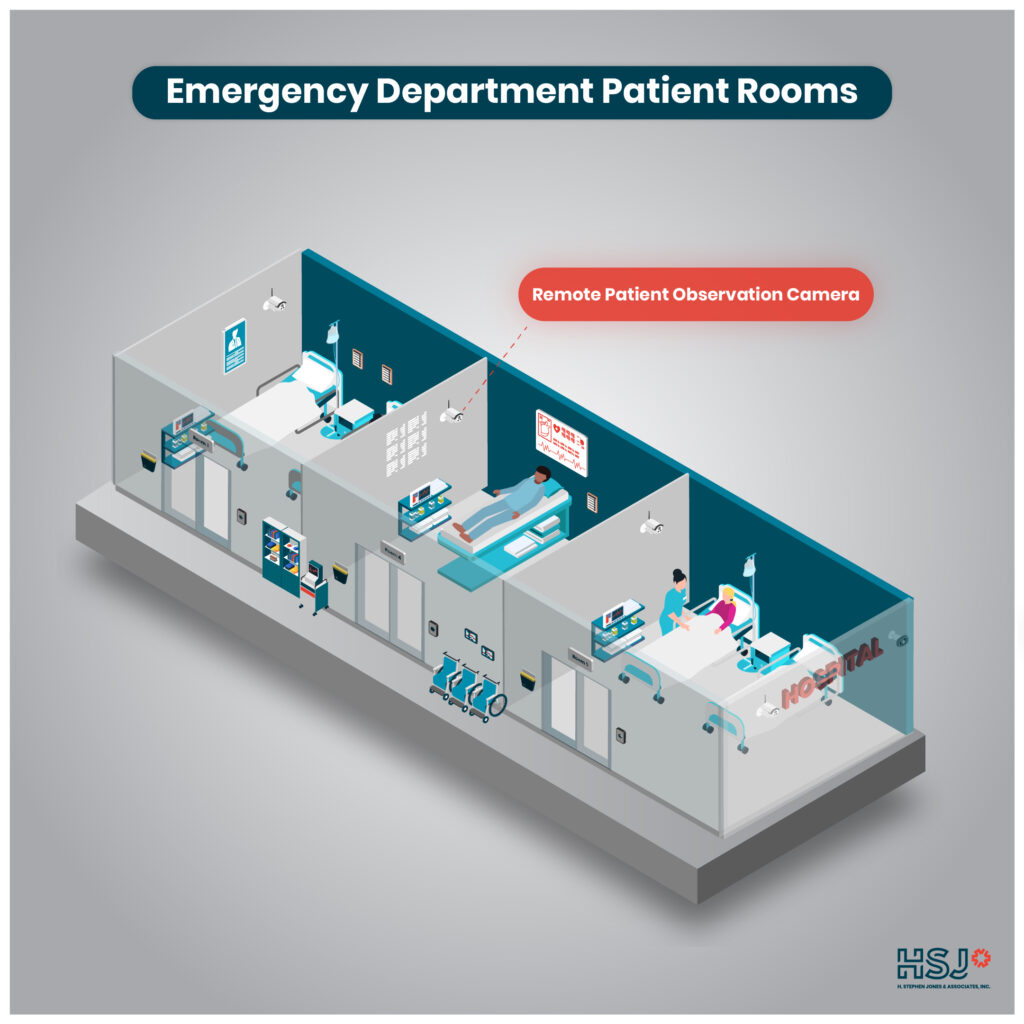
Remote Patient Observation
Empower your clinicians with the ability to monitor patients remotely from their nursing station. This lessens staff exposure to infectious diseases and also gives nurses a way to monitor patients with mental health issues without having to be dangerously close to the patient for each interaction. 2-way audio and video is also available so conversations can be had with the patient without direct contact. Many HIPPA compliant solutions for this exist already and are being widely adopted in hospitals across the US.
Nurse Station Duress Button
Nurse station duress buttons allow staff to quickly alert security if a violent event is occurring within the department. Having easy access to these duress buttons can reduce response times during an attack and mitigate injuries to staff and damage to the department. While we advocate for wearable duress solutions, having a nurse station duress button is also highly recommended.
3.) Emergency Department Perimeter
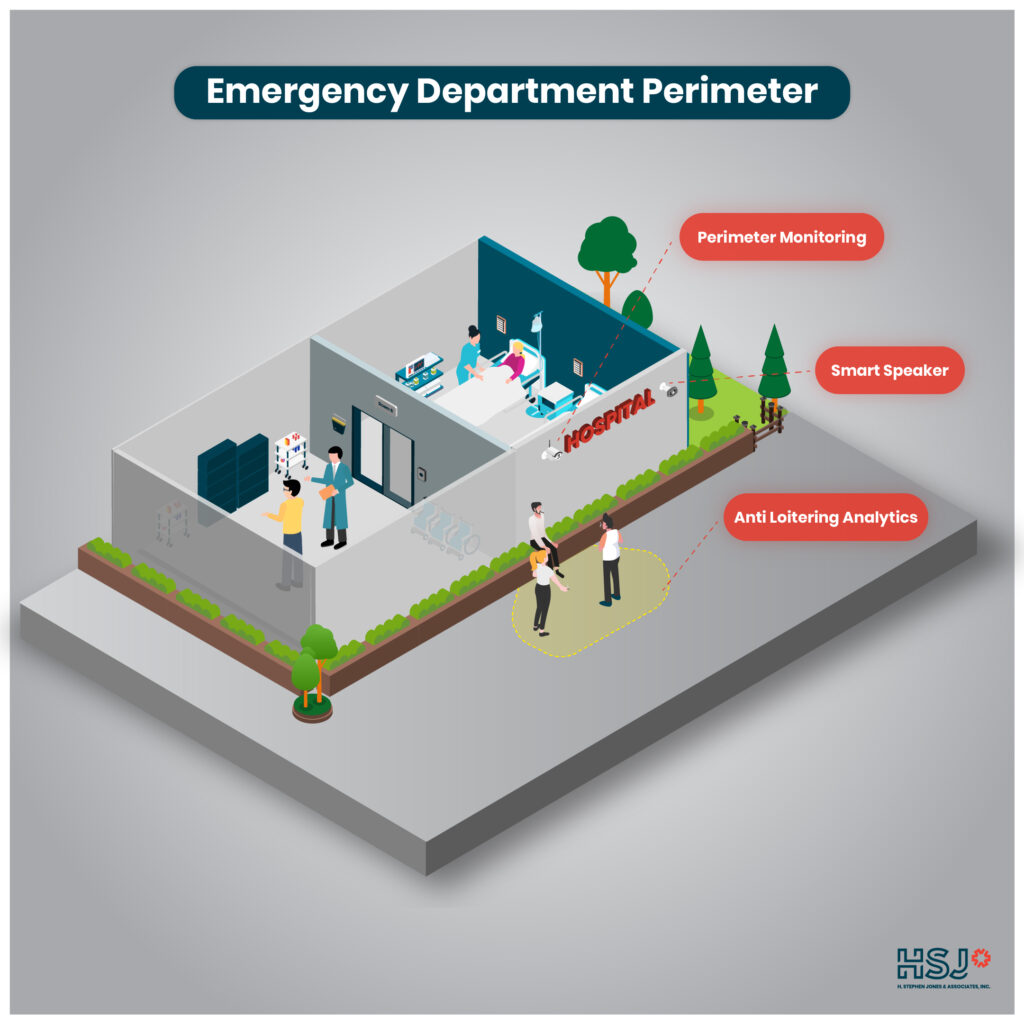
Smart Speakers
Combining smart speakers with video analytics can reduce the number of times security staff is dispatched to problematic areas. If you have an area where smoking and loitering is prohibited, a camera can detect any violation and the speaker can play a customized message asking for people to not smoke in the area. The same can be done in a no parking area if a car is detected in a place it is not supposed to be. Security operators can also make live announcements and requests through the speak for special situations.
Perimeter Monitoring
Having cameras in and around the parking area of your emergency department is critical. These camera views give you visibility into what issues could spill over into your department from your parking areas. If a disgruntled spouse or family member arrives on site and is approaching with intent for harm, your camera systems will give you an early warning. The early warnings automatically alert security teams so they can preemptively respond to the potential attack or remotely lockdown an area.
Video Analytics
Video analytics help your security staff monitor what is happening around your emergency department and provide alerts when potential threats arise. People are not built to constantly view video feeds to identify threats but new A.I. solutions are trained to detect specific patterns and events. Video analytics can detect if someone is crossing into a no trespassing zone, approaching the hospital with a weapon, or any other number of potentially risky behaviors.
See Where Your Hospital Can Improve With a Security Technology Assessment
Advancements in security technology are allowing hospitals to make good on their commitment to provide the highest quality patient care and safety. And a new wave of healthcare executives have agreed that the security guard alone can not meet today’s security needs.
It is time to consider a security technology assessment to see what your hospital is doing well, where you can improve, and how you can customize security technology to fit your hospital’s specific needs. Contact HSJ to receive more information on an assessment and the process to upgrade your security technology.

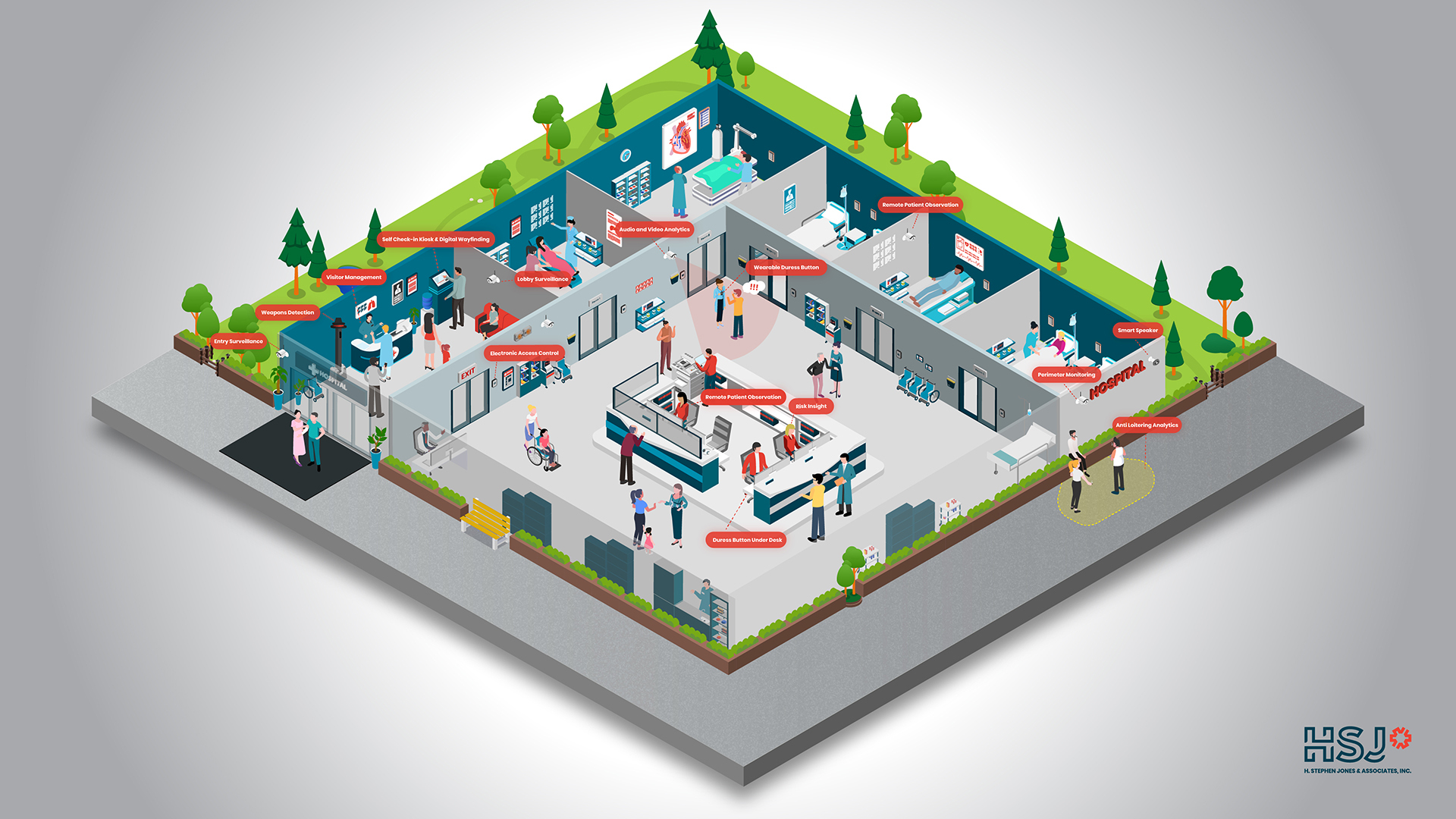
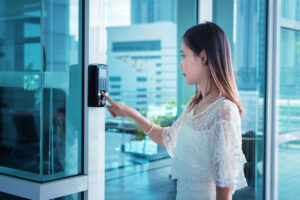


 © 2025 By H. Stephen Jones & Associates, Inc.
© 2025 By H. Stephen Jones & Associates, Inc.